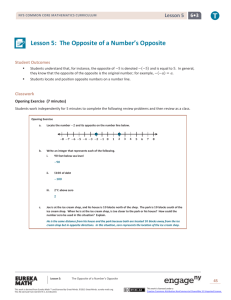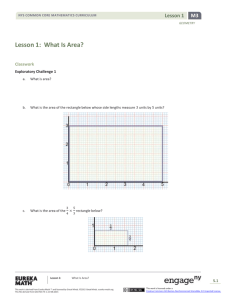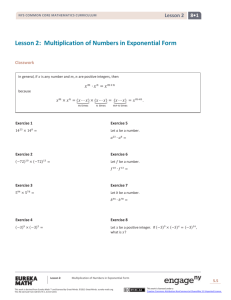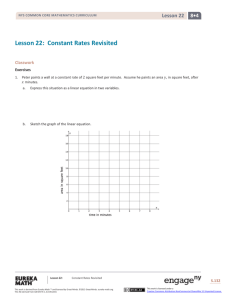Lesson 8: Replacing Numbers with Letters
advertisement
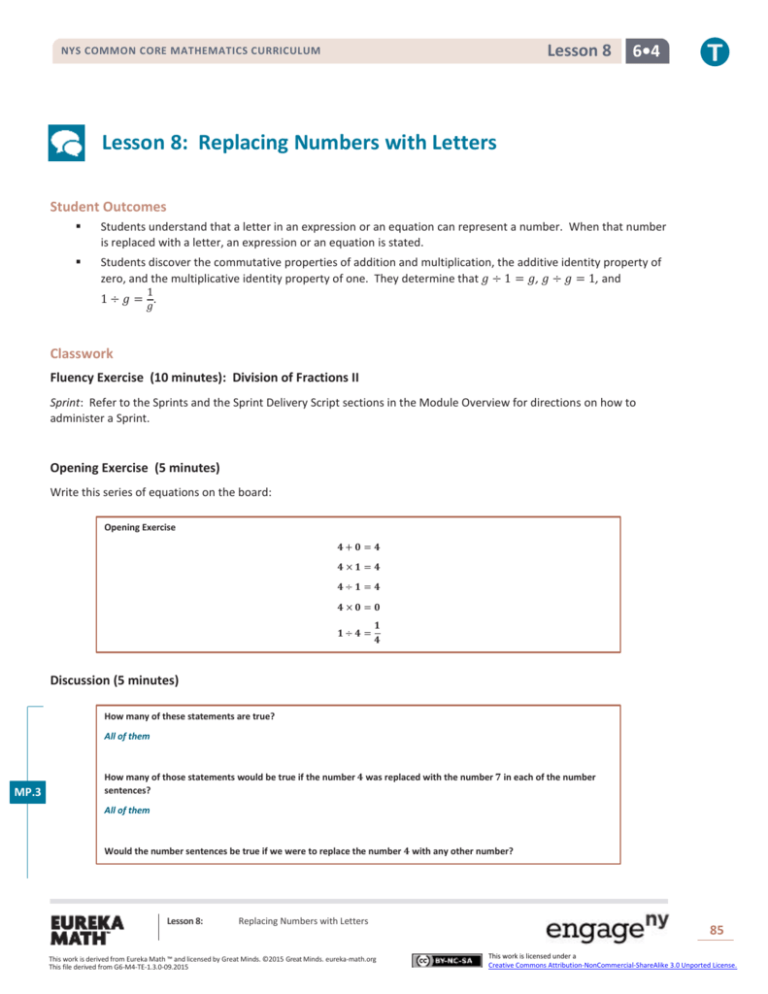
Lesson 8 NYS COMMON CORE MATHEMATICS CURRICULUM 6•4 Lesson 8: Replacing Numbers with Letters Student Outcomes Students understand that a letter in an expression or an equation can represent a number. When that number is replaced with a letter, an expression or an equation is stated. Students discover the commutative properties of addition and multiplication, the additive identity property of zero, and the multiplicative identity property of one. They determine that 𝑔 ÷ 1 = 𝑔, 𝑔 ÷ 𝑔 = 1, and 1 𝑔 1÷𝑔 = . Classwork Fluency Exercise (10 minutes): Division of Fractions II Sprint: Refer to the Sprints and the Sprint Delivery Script sections in the Module Overview for directions on how to administer a Sprint. Opening Exercise (5 minutes) Write this series of equations on the board: Opening Exercise 𝟒+𝟎 =𝟒 𝟒×𝟏 =𝟒 𝟒÷𝟏 =𝟒 𝟒×𝟎 =𝟎 𝟏÷𝟒 = 𝟏 𝟒 Discussion (5 minutes) How many of these statements are true? All of them MP.3 How many of those statements would be true if the number 𝟒 was replaced with the number 𝟕 in each of the number sentences? All of them Would the number sentences be true if we were to replace the number 𝟒 with any other number? Lesson 8: Replacing Numbers with Letters This work is derived from Eureka Math ™ and licensed by Great Minds. ©2015 Great Minds. eureka-math.org This file derived from G6-M4-TE-1.3.0-09.2015 85 This work is licensed under a Creative Commons Attribution-NonCommercial-ShareAlike 3.0 Unported License. Lesson 8 NYS COMMON CORE MATHEMATICS CURRICULUM 6•4 Let students make conjectures about substitutions. What if we replaced the number 𝟒 with the number 𝟎? Would each of the number sentences be true? No. The first four are true, but the last one, dividing by zero, is not true. MP.3 Division by zero is undefined. You cannot make zero groups of objects, and group size cannot be zero. It appears that we can replace the number 4 with any nonzero number, and each of the number sentences will be true. A letter in an expression can represent a number. When that number is replaced with a letter, an expression is stated. What if we replace the number 𝟒 with a letter 𝒈? Please write all 𝟒 expressions below, replacing each 𝟒 with a 𝒈. 𝒈+𝟎 =𝒈 𝒈×𝟏 =𝒈 𝒈÷𝟏 =𝒈 𝒈×𝟎 = 𝟎 𝟏÷𝒈 = 𝟏 𝒈 Are these all true (except for 𝒈 = 𝟎) when dividing? Yes Let’s look at each of these a little closer and see if we can make some generalizations. Example 1 (5 minutes): Additive Identity Property of Zero Example 1: Additive Identity Property of Zero 𝒈+𝟎 =𝒈 Remember a letter in a mathematical expression represents a number. Can we replace 𝒈 with any number? Yes Choose a value for 𝒈, and replace 𝒈 with that number in the equation. What do you observe? The value of 𝒈 does not change when 𝟎 is added to 𝒈. Repeat this process several times, each time choosing a different number for 𝒈. Lesson 8: Replacing Numbers with Letters This work is derived from Eureka Math ™ and licensed by Great Minds. ©2015 Great Minds. eureka-math.org This file derived from G6-M4-TE-1.3.0-09.2015 86 This work is licensed under a Creative Commons Attribution-NonCommercial-ShareAlike 3.0 Unported License. Lesson 8 NYS COMMON CORE MATHEMATICS CURRICULUM 6•4 Allow students to experiment for about a minute. Most quickly realize the additive identity property of zero: Any number added to zero equals itself. The number’s identity does not change. Will all values of 𝒈 result in a true number sentence? Yes Write the mathematical language for this property below: 𝒈 + 𝟎 = 𝒈, additive identity property of zero. Any number added to zero equals itself. Example 2 (5 minutes): Multiplicative Identity Property of One Example 2: Multiplicative Identity Property of One 𝒈×𝟏 =𝒈 Remember a letter in a mathematical expression represents a number. Can we replace 𝒈 with any number? Yes Choose a value for 𝒈, and replace 𝒈 with that number in the equation. What do you observe? The value of 𝒈 does not change when 𝒈 is multiplied by 𝟏. Allow students to experiment for about a minute with the next question. Most quickly realize the multiplicative identity property of one: Any number multiplied by 1 equals itself. The number’s identity does not change. Will all values of 𝒈 result in a true number sentence? Experiment with different values before making your claim. Yes Write the mathematical language for this property below: 𝒈 × 𝟏 = 𝒈, multiplicative identity property of one. Any number multiplied by one equals itself. Example 3 (6 minutes): Commutative Property of Addition and Multiplication Example 3: Commutative Property of Addition and Multiplication 𝟑+𝟒=𝟒+𝟑 𝟑×𝟒=𝟒×𝟑 Replace the 𝟑’s in these number sentences with the letter 𝒂. 𝒂+𝟒=𝟒+𝒂 𝒂×𝟒=𝟒×𝒂 Lesson 8: Replacing Numbers with Letters This work is derived from Eureka Math ™ and licensed by Great Minds. ©2015 Great Minds. eureka-math.org This file derived from G6-M4-TE-1.3.0-09.2015 87 This work is licensed under a Creative Commons Attribution-NonCommercial-ShareAlike 3.0 Unported License. Lesson 8 NYS COMMON CORE MATHEMATICS CURRICULUM 6•4 Choose a value for 𝒂, and replace 𝒂 with that number in each of the equations. What do you observe? The result is a true number sentence. Allow students to experiment for about a minute with the next question. Most quickly realize that the equations are examples of the commutative property of addition and commutative property of multiplication. These are sometimes called the “any-order properties.” Will all values of 𝒂 result in a true number sentence? Experiment with different values before making your claim. Yes, any number, even zero, can be used in place of the variable 𝒂. Now, write the equations again, this time replacing the number 𝟒 with a variable, 𝒃. 𝒂+𝒃 =𝒃+𝒂 𝒂×𝒃=𝒃×𝒂 Will all values of 𝒂 and 𝒃 result in true number sentences for the first two equations? Experiment with different values before making your claim. Yes Write the mathematical language for this property below: 𝒂 + 𝒃 = 𝒃 + 𝒂, commutative property of addition. Order does not matter when adding. 𝒂 × 𝒃 = 𝒃 × 𝒂, commutative property of multiplication. Order does not matter when multiplying. Models are useful for making abstract ideas more concrete. Lesson 8: Replacing Numbers with Letters This work is derived from Eureka Math ™ and licensed by Great Minds. ©2015 Great Minds. eureka-math.org This file derived from G6-M4-TE-1.3.0-09.2015 88 This work is licensed under a Creative Commons Attribution-NonCommercial-ShareAlike 3.0 Unported License. Lesson 8 NYS COMMON CORE MATHEMATICS CURRICULUM 6•4 Example 4 (4 minutes) Display and discuss the models above as they relate to the commutative property of addition and the commutative property of multiplication. When finished, pose a new question: Will all values of 𝑎 and 𝑏 result in a true number sentence for the equation 𝑎 + 𝑎 + 𝑎 + 𝑎 = 𝑏 × 𝑎? Experiment with different values before making your claim. Allow students to experiment for about a minute. They should discover that any value can be substituted for the variable 𝑎, but only 4 can be used for 𝑏, since there are exactly 4 copies of 𝑎 in the equation. Summarize your discoveries with a partner. In the equation 𝑎 + 𝑎 + 𝑎 + 𝑎 = 𝑏 × 𝑎, any value can be substituted for the variable 𝑎, but only 4 can be used for 𝑏, since there are exactly 4 copies of 𝑎 in the equation. 𝑎 𝑏 Finally, consider the last equation, 𝑎 ÷ 𝑏 = . Is this true for all values of 𝑎 and 𝑏? It is true for all values of 𝑎 and all values of 𝑏 ≠ 0. Example 4 𝟑+𝟑+𝟑+𝟑= 𝟒×𝟑 𝟑÷𝟒 = 𝟑 𝟒 Replace the 𝟑’s in these number sentences with the letter 𝒂. 𝒂+𝒂+𝒂+𝒂 =𝟒×𝒂 𝒂÷𝟒 = 𝒂 𝟒 Choose a value for 𝒂, and replace 𝒂 with that number in each of the equations. What do you observe? The result is a true number sentence. Will all values of 𝒂 result in a true number sentence? Experiment with different values before making your claim. Yes, any number, even zero, can be used in place of the variable 𝒂. Lesson 8: Replacing Numbers with Letters This work is derived from Eureka Math ™ and licensed by Great Minds. ©2015 Great Minds. eureka-math.org This file derived from G6-M4-TE-1.3.0-09.2015 89 This work is licensed under a Creative Commons Attribution-NonCommercial-ShareAlike 3.0 Unported License. Lesson 8 NYS COMMON CORE MATHEMATICS CURRICULUM 6•4 Now, write the equations again, this time replacing the number 𝟒 with a variable, 𝒃. 𝒂+𝒂+𝒂+𝒂=𝒃×𝒂 𝒂÷𝒃= 𝒂 ,𝒃≠𝟎 𝒃 Will all values of 𝒂 and 𝒃 result in true number sentences for the equations? Experiment with different values before making your claim. In the equation 𝒂 + 𝒂 + 𝒂 + 𝒂 = 𝒃 × 𝒂, any value can be substituted for the variable 𝒂, but only 𝟒 can be used for 𝒃 since there are exactly 𝟒 copies of 𝒂 in the equation. It is true for all values of 𝒂 and all values of 𝒃 ≠ 𝟎. Closing (2 minutes) Tell your partner which of these properties of numbers is the easiest for you to remember. Allow sharing for a short time. Now, tell your partner which of these properties of numbers is the hardest for you to remember. Allow sharing for a short time. Although these properties might seem simple, we apply them in many different ways in mathematics. If you have a good grasp on them, you will recognize them and use them in many applications. With a partner, create two different division problems that support the following: 𝑔 × 1 = 𝑔, and be ready to explain your reasoning. 7 8 7 8 𝑔 ÷ 𝑔 = 1; 5 ÷ 5 = 1; 34 ÷ 34 = 1; 2 ÷ 2 = 1; and so on. Any nonzero number divided by itself equals 1. If a number 𝑔 is divided into 𝑔 equal parts, each part will have a size equal to one. If 𝑔 items are divided into groups of size 𝑔, there will be one group. What about any number divided by 1? What does this mean? 𝑔÷1=𝑔 If a number 𝑔 is divided into 1 part, then the size of that part will be 𝑔. Or, if 𝑔 items are divided into 1 group, there will be 𝑔 items in that group. Exit Ticket (5 minutes) Lesson 8: Replacing Numbers with Letters This work is derived from Eureka Math ™ and licensed by Great Minds. ©2015 Great Minds. eureka-math.org This file derived from G6-M4-TE-1.3.0-09.2015 90 This work is licensed under a Creative Commons Attribution-NonCommercial-ShareAlike 3.0 Unported License. Lesson 8 NYS COMMON CORE MATHEMATICS CURRICULUM Name 6•4 Date Lesson 8: Replacing Numbers with Letters Exit Ticket 1. State the commutative property of addition, and provide an example using two different numbers. 2. State the commutative property of multiplication, and provide an example using two different numbers. 3. State the additive property of zero, and provide an example using any other number. 4. State the multiplicative identity property of one, and provide an example using any other number. Lesson 8: Replacing Numbers with Letters This work is derived from Eureka Math ™ and licensed by Great Minds. ©2015 Great Minds. eureka-math.org This file derived from G6-M4-TE-1.3.0-09.2015 91 This work is licensed under a Creative Commons Attribution-NonCommercial-ShareAlike 3.0 Unported License. Lesson 8 NYS COMMON CORE MATHEMATICS CURRICULUM 6•4 Exit Ticket Sample Solutions 1. State the commutative property of addition, and provide an example using two different numbers. Any two different addends can be chosen, such as 𝟓 + 𝟔 = 𝟔 + 𝟓. 2. State the commutative property of multiplication, and provide an example using two different numbers. Any two different factors can be chosen, such as 𝟒 × 𝟗 = 𝟗 × 𝟒. 3. State the additive property of zero, and provide an example using any other number. Any nonzero addend can be chosen, such as 𝟑 + 𝟎 = 𝟑. 4. State the multiplicative identity property of one, and provide an example using any other number. Any nonzero factor can be chosen, such as 𝟏𝟐 × 𝟏 = 𝟏𝟐. Problem Set Sample Solutions 1. State the commutative property of addition using the variables 𝒂 and 𝒃. 𝒂+𝒃=𝒃+𝒂 2. State the commutative property of multiplication using the variables 𝒂 and 𝒃. 𝒂×𝒃=𝒃×𝒂 3. State the additive property of zero using the variable 𝒃. 𝒃+𝟎= 𝒃 4. State the multiplicative identity property of one using the variable 𝒃. 𝒃×𝟏=𝒃 5. Demonstrate the property listed in the first column by filling in the third column of the table. 𝟐𝟓 + 𝒄 = 𝒄 + 𝟐𝟓 Commutative Property of Multiplication 𝒍×𝒘= 𝒘×𝒍 Additive Property of Zero 𝒉+𝟎 = 𝒉 Multiplicative Identity Property of One 𝒗×𝟏 = 𝒗 Commutative Property of Addition 6. Why is there no commutative property for subtraction or division? Show examples. Answers will vary. Examples should show reasoning and proof that the commutative property does not work for 𝟏 𝟒 subtraction and division. An example would be 𝟖 ÷ 𝟐 and 𝟐 ÷ 𝟖. 𝟖 ÷ 𝟐 = 𝟒, but 𝟐 ÷ 𝟖 = . Lesson 8: Replacing Numbers with Letters This work is derived from Eureka Math ™ and licensed by Great Minds. ©2015 Great Minds. eureka-math.org This file derived from G6-M4-TE-1.3.0-09.2015 92 This work is licensed under a Creative Commons Attribution-NonCommercial-ShareAlike 3.0 Unported License. Lesson 8 NYS COMMON CORE MATHEMATICS CURRICULUM 6•4 Number Correct: ______ Division of Fractions II—Round 1 Directions: Determine the quotient of the fractions and simplify. 1. 4 2 ÷ 10 10 16. 1 2 3 ÷ 8 3 2. 9 3 ÷ 12 12 17. 5 1 1 ÷ 6 2 3. 6 4 ÷ 10 10 18. 5 3 ÷2 8 4 4. 2 3 ÷ 8 8 19. 1 4 ÷1 3 5 5. 2 6 ÷ 7 7 20. 3 3 ÷2 4 10 6. 11 8 ÷ 9 9 21. 1 1 2 ÷1 5 6 7. 5 10 ÷ 13 13 22. 4 3 2 ÷1 9 5 8. 7 13 ÷ 8 16 23. 2 2 1 ÷3 9 5 9. 3 7 ÷ 5 10 24. 2 2 ÷3 3 10. 9 3 ÷ 30 5 25. 3 2 1 ÷2 4 5 11. 1 4 ÷ 3 5 26. 4÷1 12. 2 3 ÷ 5 4 27. 1 3 ÷6 5 13. 3 5 ÷ 4 9 28. 5 1 2 ÷1 6 3 14. 4 7 ÷ 5 12 29. 2 10 ÷ 8 3 15. 3 5 ÷ 8 2 30. 15 ÷ 2 Lesson 8: Replacing Numbers with Letters This work is derived from Eureka Math ™ and licensed by Great Minds. ©2015 Great Minds. eureka-math.org This file derived from G6-M4-TE-1.3.0-09.2015 2 9 3 5 93 This work is licensed under a Creative Commons Attribution-NonCommercial-ShareAlike 3.0 Unported License. Lesson 8 NYS COMMON CORE MATHEMATICS CURRICULUM 6•4 Division of Fractions II—Round 1 [KEY] Directions: Determine the quotient of the fractions and simplify. 1. 4 2 ÷ 10 10 𝟒 =𝟐 𝟐 16. 1 2 3 ÷ 8 3 𝟕𝟓 𝟏𝟏 =𝟒 𝟏𝟔 𝟏𝟔 2. 9 3 ÷ 12 12 𝟗 =𝟑 𝟑 17. 5 1 1 ÷ 6 2 𝟐𝟐 𝟏𝟏 𝟐 = =𝟑 𝟔 𝟑 𝟑 3. 6 4 ÷ 10 10 𝟔 𝟑 𝟏 = =𝟏 𝟒 𝟐 𝟐 18. 5 3 ÷2 8 4 𝟐𝟎 𝟓 = 𝟖𝟖 𝟐𝟐 4. 2 3 ÷ 8 8 𝟐 𝟑 19. 1 4 ÷1 3 5 𝟓 𝟐𝟕 5. 2 6 ÷ 7 7 𝟐 𝟏 = 𝟔 𝟑 20. 3 3 ÷2 4 10 𝟑𝟎 𝟏𝟓 = 𝟗𝟐 𝟒𝟔 6. 11 8 ÷ 9 9 𝟏𝟏 𝟑 =𝟏 𝟖 𝟖 21. 1 1 2 ÷1 5 6 𝟔𝟔 𝟑𝟏 =𝟏 𝟑𝟓 𝟑𝟓 7. 5 10 ÷ 13 13 𝟓 𝟏 = 𝟏𝟎 𝟐 22. 4 3 2 ÷1 9 5 𝟏𝟏𝟎 𝟓𝟓 𝟏𝟗 = =𝟏 𝟕𝟐 𝟑𝟔 𝟑𝟔 8. 7 13 ÷ 8 16 𝟏𝟒 𝟏 =𝟏 𝟏𝟑 𝟏𝟑 23. 2 2 1 ÷3 9 5 𝟓𝟓 𝟏𝟓𝟑 9. 3 7 ÷ 5 10 𝟔 𝟕 24. 2 2 ÷3 3 𝟖 𝟗 10. 9 3 ÷ 30 5 𝟗 𝟏 = 𝟏𝟖 𝟐 25. 3 2 1 ÷2 4 5 𝟑𝟓 𝟒𝟖 11. 1 4 ÷ 3 5 𝟓 𝟏𝟐 26. 4÷1 12. 2 3 ÷ 5 4 𝟖 𝟏𝟓 27. 1 3 ÷6 5 𝟏𝟔 𝟖 = 𝟑𝟎 𝟏𝟓 13. 3 5 ÷ 4 9 𝟐𝟕 𝟕 =𝟏 𝟐𝟎 𝟐𝟎 28. 5 1 2 ÷1 6 3 𝟓𝟏 𝟑 𝟏 =𝟐 =𝟐 𝟐𝟒 𝟐𝟒 𝟖 14. 4 7 ÷ 5 12 𝟒𝟖 𝟏𝟑 =𝟏 𝟑𝟓 𝟑𝟓 29. 2 10 ÷ 8 3 𝟑𝟐 𝟒 𝟏 = =𝟏 𝟐𝟒 𝟑 𝟑 15. 3 5 ÷ 8 2 𝟔 𝟑 = 𝟒𝟎 𝟐𝟎 30. 15 ÷ 2 Lesson 8: Replacing Numbers with Letters This work is derived from Eureka Math ™ and licensed by Great Minds. ©2015 Great Minds. eureka-math.org This file derived from G6-M4-TE-1.3.0-09.2015 2 9 3 5 𝟑𝟔 𝟑 =𝟑 𝟏𝟏 𝟏𝟏 𝟕𝟓 𝟏𝟎 =𝟓 𝟏𝟑 𝟏𝟑 94 This work is licensed under a Creative Commons Attribution-NonCommercial-ShareAlike 3.0 Unported License. Lesson 8 NYS COMMON CORE MATHEMATICS CURRICULUM 6•4 Number Correct: ______ Improvement: ______ Division of Fractions II—Round 2 Directions: Determine the quotient of the fractions and simplify. 1. 10 5 ÷ 2 2 16. 5 3 ÷1 8 4 2. 6 3 ÷ 5 5 17. 1 2 ÷2 4 5 3. 10 2 ÷ 7 7 18. 3 3 2 ÷ 5 8 4. 3 5 ÷ 8 8 19. 3 2 1 ÷ 5 9 5. 1 3 ÷ 4 12 20. 4÷2 6. 7 3 ÷ 5 10 21. 1 1 ÷5 2 7. 8 4 ÷ 15 5 22. 1 3 3 ÷1 3 4 8. 5 5 ÷ 6 12 23. 2 1 2 ÷1 5 4 9. 3 7 ÷ 5 9 24. 1 2 3 ÷2 2 3 10. 3 3 ÷ 10 9 25. 4 3 1 ÷2 5 4 11. 3 7 ÷ 4 9 26. 1 3 3 ÷1 6 5 12. 7 3 ÷ 10 8 27. 3 1 3 ÷2 5 8 13. 4÷ 4 9 28. 5÷1 14. 5 ÷7 8 29. 3 1 3 ÷5 4 2 15. 9÷ 2 3 30. 2 1 4 ÷5 3 4 Lesson 8: Replacing Numbers with Letters This work is derived from Eureka Math ™ and licensed by Great Minds. ©2015 Great Minds. eureka-math.org This file derived from G6-M4-TE-1.3.0-09.2015 3 8 1 6 95 This work is licensed under a Creative Commons Attribution-NonCommercial-ShareAlike 3.0 Unported License. Lesson 8 NYS COMMON CORE MATHEMATICS CURRICULUM 6•4 Division of Fractions II—Round 2 [KEY] Directions: Determine the quotient of the fractions and simplify. 1. 10 5 ÷ 2 2 𝟏𝟎 =𝟐 𝟓 16. 5 3 ÷1 8 4 𝟐𝟎 𝟓 = 𝟓𝟔 𝟏𝟒 2. 6 3 ÷ 5 5 𝟔 =𝟐 𝟑 17. 1 2 ÷2 4 5 𝟓 𝟒𝟖 3. 10 2 ÷ 7 7 𝟏𝟎 =𝟓 𝟐 18. 3 3 2 ÷ 5 8 𝟏𝟎𝟒 𝟏𝟒 =𝟔 𝟏𝟓 𝟏𝟓 4. 3 5 ÷ 8 8 𝟑 𝟓 19. 3 2 1 ÷ 5 9 𝟕𝟐 𝟐 𝟏 =𝟕 =𝟕 𝟏𝟎 𝟏𝟎 𝟓 5. 1 3 ÷ 4 12 𝟑 =𝟏 𝟑 20. 4÷2 6. 7 3 ÷ 5 10 𝟏𝟒 𝟐 =𝟒 𝟑 𝟑 21. 1 1 ÷5 2 𝟑 𝟏𝟎 7. 8 4 ÷ 15 5 𝟖 𝟐 = 𝟏𝟐 𝟑 22. 1 3 3 ÷1 3 4 𝟒𝟎 𝟏𝟗 =𝟏 𝟐𝟏 𝟐𝟏 8. 5 5 ÷ 6 12 𝟏𝟎 =𝟐 𝟓 23. 2 1 2 ÷1 5 4 𝟒𝟖 𝟐𝟑 =𝟏 𝟐𝟓 𝟐𝟓 9. 3 7 ÷ 5 9 𝟐𝟕 𝟑𝟓 24. 1 2 3 ÷2 2 3 𝟐𝟏 𝟓 =𝟏 𝟏𝟔 𝟏𝟔 10. 3 3 ÷ 10 9 𝟐𝟕 𝟗 = 𝟑𝟎 𝟏𝟎 25. 4 3 1 ÷2 5 4 𝟑𝟔 𝟓𝟓 11. 3 7 ÷ 4 9 𝟐𝟕 𝟐𝟖 26. 1 3 3 ÷1 6 5 𝟗𝟓 𝟒𝟕 =𝟏 𝟒𝟖 𝟒𝟖 12. 7 3 ÷ 10 8 𝟓𝟔 𝟐𝟖 𝟏𝟑 = =𝟏 𝟑𝟎 𝟏𝟓 𝟏𝟓 27. 3 1 3 ÷2 5 8 𝟏𝟒𝟒 𝟓𝟗 =𝟏 𝟖𝟓 𝟖𝟓 13. 4÷ 𝟑𝟔 =𝟗 𝟒 28. 5÷1 1 6 𝟑𝟎 𝟐 =𝟒 𝟕 𝟕 14. 5 ÷7 8 𝟓 𝟓𝟔 29. 3 1 3 ÷5 4 2 𝟑𝟎 𝟏𝟓 = 𝟒𝟒 𝟐𝟐 15. 9÷ 𝟐𝟕 𝟏 = 𝟏𝟑 𝟐 𝟐 30. 2 1 4 ÷5 3 4 𝟓𝟔 𝟖 = 𝟔𝟑 𝟗 4 9 2 3 Lesson 8: Replacing Numbers with Letters This work is derived from Eureka Math ™ and licensed by Great Minds. ©2015 Great Minds. eureka-math.org This file derived from G6-M4-TE-1.3.0-09.2015 3 8 𝟑𝟐 𝟏𝟑 =𝟏 𝟏𝟗 𝟏𝟗 96 This work is licensed under a Creative Commons Attribution-NonCommercial-ShareAlike 3.0 Unported License.





